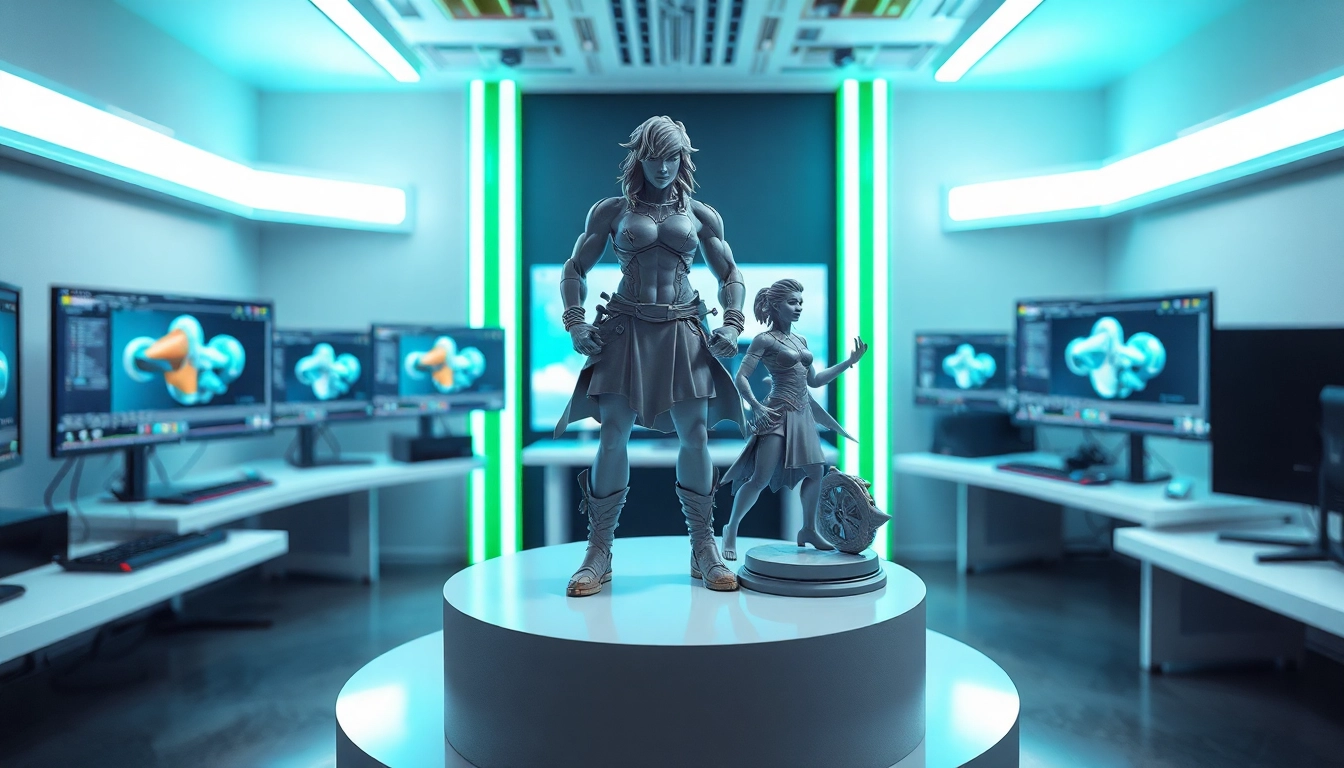Understanding 3D Modeling Services
In the realm of design and technology, 3D modeling services play a pivotal role in bringing concepts to life. This innovative technique allows creators, engineers, designers, and artists to construct three-dimensional representations of objects, environments, and characters, facilitating the visualization of ideas before they materialize in the physical world. This comprehensive guide delves into the intricacies of 3D modeling services, exploring various aspects, applications, and factors to consider when selecting a modeling service provider.
What Are 3D Modeling Services?
3D modeling services encompass the process of creating digital representations of physical objects in a three-dimensional format. This involves using specialized software to create a geometry that simulates how objects look in real life, adding textures, colors, and lighting effects to enhance realism. The resulting models are used in various industries, including gaming, film, architecture, product design, and virtual reality.
Types of 3D Modeling
There are several distinct types of 3D modeling techniques, each serving different purposes and tailored to specific industries:
- Polygonal Modeling: This technique uses polygons to create 3D objects, often employed in game design and animation.
- Sculpting: Artists manipulate a digital model as if sculpting clay, allowing for intricate detailing, commonly used in character design.
- NURBS Modeling: Non-Uniform Rational B-Splines (NURBS) offer smooth surfaces and are used mainly in automotive and industrial design.
- Parametric Modeling: This type involves using mathematical equations to model shapes, making it flexible and adjustable for architectural projects.
- 3D Scanning: Physical objects are scanned and transformed into digital models, useful in reverse engineering and historical preservation.
Applications of 3D Modeling Services
The applications of 3D modeling are vast and varied, influencing numerous sectors:
- Product Design: Businesses utilize 3D modeling to design products, enabling prototyping and testing in a virtual environment before production.
- Architecture: 3D models assist architects in visualizing buildings, facilitating better designs and presentations for clients.
- Entertainment: In gaming and film, 3D models contribute to creating immersive worlds and realistic characters, helping to tell compelling stories.
- Medical: 3D modeling is instrumental in visualizing complex anatomy and creating simulations for surgical procedures.
- Education: In educational settings, 3D models enhance learning experiences, making abstract concepts more tangible.
Choosing the Right 3D Modeling Service
Factors to Consider
Selecting the right 3D modeling service requires careful consideration of several factors to ensure the outcome meets your specific needs:
- Project Scope and Complexity: Understand the complexity of your project and select a service provider that has proven experience in handling similar tasks.
- Portfolio and Proven Track Record: Evaluate the portfolio of potential modeling services to assess their artistic style, technical expertise, and previous work.
- Technology Used: Ensure that the service uses modern, efficient software and tools that align with industry standards for optimal results.
- Customer Support: Opt for services that provide reliable customer support and communication, as collaboration is crucial in 3D modeling projects.
- Reviews and Testimonials: Research feedback from previous clients to gain insight into the service provider’s reliability, quality, and timeliness.
Evaluating Service Providers
To thoroughly evaluate 3D modeling service providers, you may consider the following strategies:
- Compare Services: Look at different providers and compare their offerings, price points, and turnaround times.
- Request Samples: Ask for sample works or case studies that demonstrate their capabilities and past success stories.
- Discuss Techniques: Have conversations about their modeling techniques and how these can be aligned with your project goals.
- Establish Communication: Assess their willingness to communicate effectively and provide regular updates throughout the project.
Understanding Pricing Models
Pricing models for 3D modeling services can vary widely and depend on various factors, such as project complexity, level of detail required, and turnaround time. Common pricing structures include:
- Hourly Rates: Depending on the artist’s experience and skill level, hourly rates can range from $25 to $150 or more.
- Fixed Pricing: For well-defined projects, fixed pricing can be beneficial as it provides clarity on costs upfront.
- Project-based Pricing: Complex projects may require a tailored quote based on the project’s unique requirements.
Best Practices for 3D Modeling
Effective Communication with 3D Artists
Effective communication is vital for the success of any 3D modeling project. Here are some best practices:
- Define Clear Objectives: Clearly outline your project goals, timelines, and deliverables to avoid miscommunication.
- Discuss Vision: Share your ideas, inspirations, and references to convey the desired outcome effectively.
- Utilize Visual Aids: Use sketches, photographs, or mood boards to give the artist a clearer understanding of your vision.
Setting Project Expectations
Setting project expectations right from the start can mitigate potential challenges down the line. When beginning with a 3D modeling service, consider the following:
- Establish Milestones: Set clear milestones and deadlines to track progress and make adjustments as necessary.
- Feedback Loops: Establish a process for periodic feedback to ensure the project stays aligned with your expectations.
Utilizing Feedback in 3D Projects
Feedback is essential in refining a project, especially in creative fields like 3D modeling. To harness the power of feedback:
- Be Constructive: Provide specific and constructive feedback to help the artist understand what works and what doesn’t.
- Prioritize Changes: Identify the most crucial changes that need to be addressed to enhance the final product.
Case Studies: Successful Implementation
3D Modeling in Product Design
One notable case study of successful 3D modeling implementation is seen in the field of product design. Companies like Apple utilize advanced 3D modeling to prototype their products, allowing them to visualize and test every aspect of the design before it goes to manufacturing. This reduces costs and time while increasing efficiency in the development process.
Success Stories from Various Industries
The use of 3D modeling can be witnessed across various industries, with companies reporting dramatic improvements in productivity and customer satisfaction:
- Automotive Industry: Car manufacturers use 3D modeling to create prototypes, allowing for rapid iterations during the design process, significantly reducing the time to market.
- Healthcare: Medical professionals use 3D models of patient anatomy for pre-surgical planning, resulting in improved surgical outcomes.
Lessons Learned from Real Projects
A key lesson learned from successful 3D modeling implementations is the importance of flexibility. Adopting an iterative approach allows for adjustments based on client feedback, enhancing the final product. Moreover, investing time into the planning phase pays off by reducing costly revisions later in the process.
The Future of 3D Modeling Services
Trends Shaping the Industry
The future of 3D modeling is bright, with several emerging trends expected to shape its evolution:
- Integration with AI: Artificial intelligence is likely to play a key role in automating parts of the 3D modeling process, enhancing speed and accuracy.
- Increased Use of Augmented and Virtual Reality: These technologies will further enhance the user experience by allowing users to interact with 3D models in real-time.
Technological Innovations
As technology continues to evolve, so do the tools and software used in 3D modeling:
- Cloud-Based Modeling: A shift toward cloud-based modeling solutions enables collaborative work environments, allowing multiple users to work on 3D models simultaneously.
- Mobile Applications: The rise of mobile apps for 3D modeling makes it accessible to amateur designers and hobbyists, democratizing the ability to create and visualize in 3D.
Preparing for Emerging Opportunities
As the 3D modeling landscape evolves, professionals should focus on continuous learning and adaptation:
- Stay Updated: Regularly pursue further education and training to remain competitive and knowledgeable about new technologies.
- Network with Industry Professionals: Engaging with the community can unveil collaborative opportunities and insights into best practices and emerging trends.



